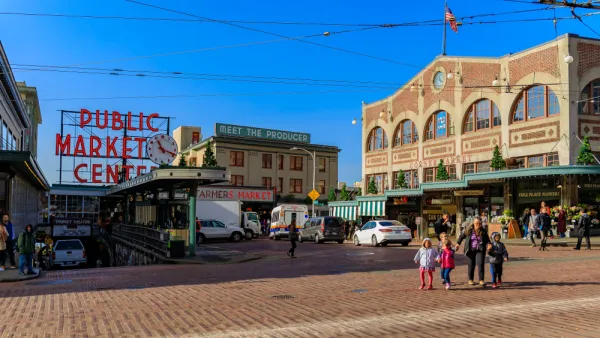Farmers Markets have exploded over the past decade. This phenomenon has not only brought more vegetables to cities but revitalization in the public.
Nothing quite says springtime like a farmer’s table loaded with kale, mustard greens, and spinach. And with the arrival of warmer days, soon communities will be enjoying the benefits of fresh, locally grown produce. Though farmers markets are often criticized over affordability and exclusivity, the appetite for them has grown significantly. In 1994, there were 1,700 markets nationwide; now, there are more than eight thousand. The proliferation of baby bok choy is indeed cause for praise. Markets help circulate dollars locally. More vegetables mean slimmer waistlines. And farmers markets can revitalize neighborhoods. These markets can also serve as a setting for what Jane Jacobs called the “sidewalk ballet,” a public space connecting people to each other. Their diverse functions—shopping, eating, or simply engaging neighbors—facilitate social interactions. In fact, the farmers market is unfortunately one of the few remaining civic places that facilitates such shared public encounters.
The decline of mixed public spaces can be traced back to the early twentieth century, when public officials began partitioning cities into areas based on functionality. At first, zoning was a public health initiative, especially in industrial cities plagued with unregulated pollution, rubbish disposal, and sewage handling. To keep factories and housing far apart, urban planners created restricted residential and industrial zones. However, a form of zoning logic, known as redlining, began to isolate populations of the city along lines of race and class. (The effects of redlining became more pronounced by the mid-twentieth century.) With the further help of the automobile and the suburbs, American cities became even more demographically and functionally divided.
FULL STORY: The Triumph of the Farmers Market

National Parks Layoffs Will Cause Communities to Lose Billions
Thousands of essential park workers were laid off this week, just before the busy spring break season.

Retro-silient?: America’s First “Eco-burb,” The Woodlands Turns 50
A master-planned community north of Houston offers lessons on green infrastructure and resilient design, but falls short of its founder’s lofty affordability and walkability goals.

Delivering for America Plan Will Downgrade Mail Service in at Least 49.5 Percent of Zip Codes
Republican and Democrat lawmakers criticize the plan for its disproportionate negative impact on rural communities.

Test News Post 1
This is a summary

Test News Headline 46
Test for the image on the front page.

Balancing Bombs and Butterflies: How the National Guard Protects a Rare Species
The National Guard at Fort Indiantown Gap uses GIS technology and land management strategies to balance military training with conservation efforts, ensuring the survival of the rare eastern regal fritillary butterfly.
Urban Design for Planners 1: Software Tools
This six-course series explores essential urban design concepts using open source software and equips planners with the tools they need to participate fully in the urban design process.
Planning for Universal Design
Learn the tools for implementing Universal Design in planning regulations.
EMC Planning Group, Inc.
Planetizen
Planetizen
Mpact (formerly Rail~Volution)
Great Falls Development Authority, Inc.
HUDs Office of Policy Development and Research
NYU Wagner Graduate School of Public Service



























